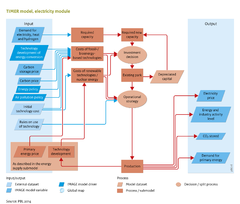Energy conversion/Description: Difference between revisions
Jump to navigation
Jump to search
Oostenrijr (talk | contribs) No edit summary |
Oostenrijr (talk | contribs) No edit summary |
||
| Line 5: | Line 5: | ||
===Electric power generation=== | ===Electric power generation=== | ||
<div class="version newv31"> | <div class="version newv31"> | ||
In TIMER, electricity can be generated by 28 technologies. These include the VRE sources solar photovoltaics (PV), concentrated solar power (CSP), and onshore and offshore wind power. Other technology types are natural gas-, coal-, biomass- and oil-fired power plants. These power plants come in multiple variations: conventional, combined cycle, carbon capture and storage (CCS) and combined heat and power (CHP). The electricity sector in TIMER also describes the use of nuclear, other renewables (mainly geothermal power) and hydroelectric power. ([[De Boer and Van Vuuren, | In TIMER, electricity can be generated by 28 technologies. These include the VRE sources solar photovoltaics (PV), concentrated solar power (CSP), and onshore and offshore wind power. Other technology types are natural gas-, coal-, biomass- and oil-fired power plants. These power plants come in multiple variations: conventional, combined cycle, carbon capture and storage (CCS) and combined heat and power (CHP). The electricity sector in TIMER also describes the use of nuclear, other renewables (mainly geothermal power) and hydroelectric power. ([[De Boer and Van Vuuren, 2017]]) | ||
</div> | </div> | ||
| Line 18: | Line 18: | ||
The final demand for new generation capacity is equal to the difference between the required and existing capacity. Power capacity is assumed to be replaced at the end of its lifetime, which varies from 25 to 80 years, depending on the technology. | The final demand for new generation capacity is equal to the difference between the required and existing capacity. Power capacity is assumed to be replaced at the end of its lifetime, which varies from 25 to 80 years, depending on the technology. | ||
Capacity can also be decommissioned before the end of the technical life time. This so-called early retirement can occur if the operation of the capacity has become relatively expensive compared to the operation and construction of new capacity. The operational costs include fixed O&M, variable O&M, fuel and CCS costs. Capacity will not be retired early if the capacity has a backup role, characterized by a low load factor resulting in low operational costs. ([[De Boer and Van Vuuren, | Capacity can also be decommissioned before the end of the technical life time. This so-called early retirement can occur if the operation of the capacity has become relatively expensive compared to the operation and construction of new capacity. The operational costs include fixed O&M, variable O&M, fuel and CCS costs. Capacity will not be retired early if the capacity has a backup role, characterized by a low load factor resulting in low operational costs. ([[De Boer and Van Vuuren, 2017]]) | ||
</div> | </div> | ||
Revision as of 08:58, 13 June 2018
Parts of Energy conversion/Description
| Component is implemented in: |
|
| Related IMAGE components |
| Projects/Applications |
| Models/Databases |
| Key publications |
| References |
